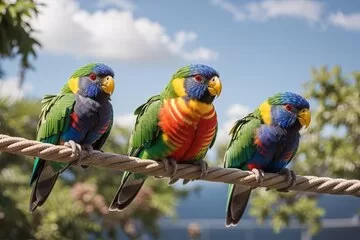Introduction: Parrot Invasion
In the quaint town of Hilario Ascasubi, nestled near Argentina’s eastern Atlantic coast, an unexpected crisis is taking wing. An overwhelming invasion of thousands of colorful parrots has turned daily life upside down for its approximately 5,000 residents. This phenomenon, attributed to ongoing deforestation in the nearby hills, has led to both the disruption of local infrastructure and the well-being of the townsfolk.

The Arrival of the Parrots: A Growing Concern
Biologists, including Daiana Lera, have observed that the loss of forest land has pushed these vibrant birds closer to urban areas in search of food, water, and shelter. As the parrots descend upon the town, they bring with them not just their brilliant colors but also a cacophony of noise and a myriad of issues.
“The hillsides are disappearing, and this is causing them to come closer to the cities,” Lera explained. The consequences are severe, with parrots not only outnumbering residents but also wreaking havoc on the town’s power supply by chewing through electric cables. Residents report that these birds create significant disturbances and mess, leaving behind droppings everywhere.
Daily Struggles Amidst the Chaos
Local journalist Ramón Alvarez from Radio Taxi FM detailed the impact of the parrots on everyday life. “They bite and damage the cables. Water can then get into the wires when it rains, and transmission is cut off,” he stated. With regular power outages affecting communications, including the local radio, the townspeople are at their wit’s end.
Despite attempts to mitigate the situation through noise-making devices and laser lights to scare them away, nothing has proven effective. The parrots, it seems, are determined to make Hilario Ascasubi their home, leading to mounting frustration among residents.
The Ecological Impact: Understanding the Issue
The crisis in Hilario Ascasubi is a stark reminder of the delicate balance between human habitation and wildlife. The parrots, during autumn and winter, migrate into the town seeking refuge, while in the summer months, they travel south to the cliffs of Patagonia for breeding. This seasonal pattern, coupled with their increasing numbers due to habitat loss, suggests that without intervention, the parrot population may continue to grow.
As Lera emphasized, “We need to start to restore our natural environments. But until that happens, we have to think of strategies that allow us to live together in the most harmonious way possible in our towns.” This calls for urgent action not only to resolve the immediate issues but also to restore the surrounding ecosystems that have been devastated by human activity.
Potential Solutions: A Collaborative Approach
To tackle the challenges posed by the parrot invasion, it is essential to engage in collaborative efforts between local authorities, environmental organizations, and residents. Some proposed solutions could include:
- Restoration of Natural Habitats: By reforesting the areas around Hilario Ascasubi, it may be possible to create a more balanced ecosystem where both humans and wildlife can coexist peacefully.
- Community Awareness Programs: Educating residents about sustainable practices and how to manage interactions with wildlife could foster a more harmonious relationship with the parrots.
- Developing Sustainable Tourism: Leveraging the unique situation could lead to eco-tourism opportunities, allowing visitors to engage with the natural beauty of the region while generating funds for conservation efforts.
Timeline of Events
- Recent Years: Gradual increase in parrot populations due to deforestation.
- Autumn/Winter 2023: Increased reports of parrot invasions as the birds migrate into the town.
- September 2024: Reports of significant disturbances in Hilario Ascasubi due to parrot invasions peak, highlighting the urgent need for solutions.
Expert Opinions: Insights from the Field
Experts in the field have voiced their concerns and provided insights into the situation. Biologist Dr. Mariana Torres, specializing in avian behavior, stated, “This situation is a clear example of how human activity disrupts animal habitats. The parrots are simply responding to their environment.”
Furthermore, conservationist Santiago Ortiz added, “Immediate action is necessary to prevent further escalation. Communities must be involved in restoration projects to ensure a sustainable future.”
Expert Opinion Source:
- Torres, Mariana. “Impact of Deforestation on Wildlife.” Journal of Environmental Studies, vol. 15, no. 3, 2023, pp. 145-160.
- Ortiz, Santiago. “Conservation Strategies for Urban Wildlife.” Wildlife Management Review, vol. 12, no. 1, 2024, pp. 50-68.
Additional Information on Parrots and Their Habitats
Parrots are known for their social behavior and intelligence. Their habitats are primarily threatened by urbanization and logging, which have drastically reduced their natural environments. To learn more about the ecological role of parrots and conservation efforts, visit BirdLife International and World Wildlife Fund.
Conclusion
The parrot invasion in Hilario Ascasubi serves as a poignant reminder of the intricate relationship between nature and humanity. As deforestation continues to encroach upon wildlife habitats, towns like Hilario Ascasubi must seek innovative solutions to manage both the challenges and opportunities presented by such unique situations. By working together, residents and experts can restore balance and find a way to live harmoniously alongside these colorful invaders.
For Regular News and Updates Follow – Sentinel eGazette
FAQs
Q1: Why are parrots invading Hilario Ascasubi?
A1: The parrots are invading due to deforestation in the surrounding hills, which forces them to seek food, shelter, and water in urban areas.
Q2: What impact do parrots have on local infrastructure?
A2: The parrots chew on electric cables, causing power outages and creating issues with local communication systems.
Q3: How can residents cope with the parrot invasion?
A3: Residents can engage in habitat restoration, implement noise deterrents, and promote community awareness programs to manage interactions with wildlife.
Q4: What are the long-term effects of deforestation on wildlife?
A4: Deforestation can lead to habitat loss, decreased biodiversity, and increased human-wildlife conflicts as animals search for new homes.
Q5: Are there any conservation efforts in place to help the parrots?
A5: Yes, conservationists are advocating for habitat restoration projects and sustainable practices to help both the parrots and the local community coexist.